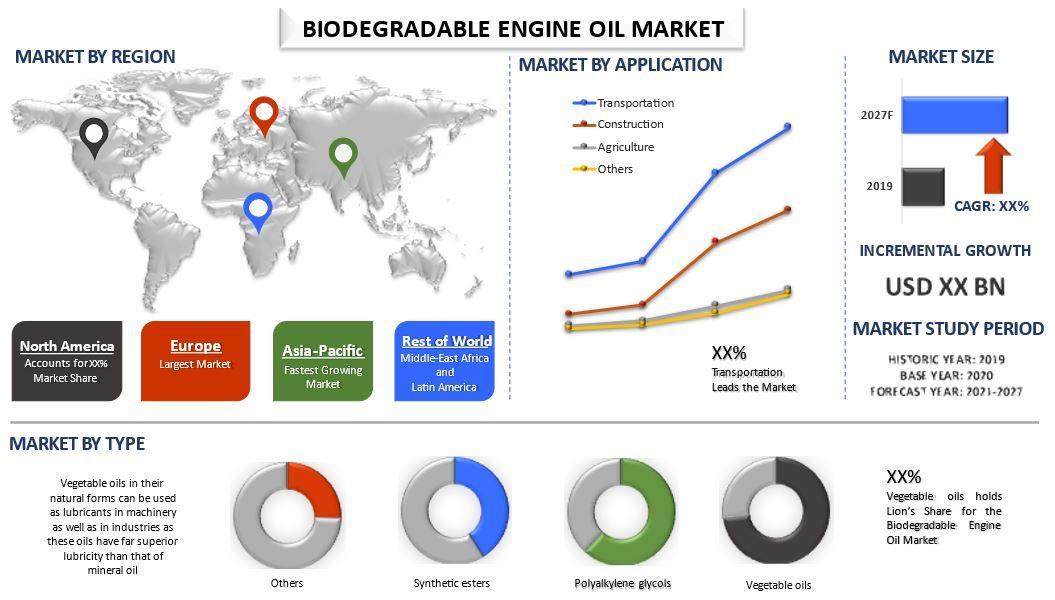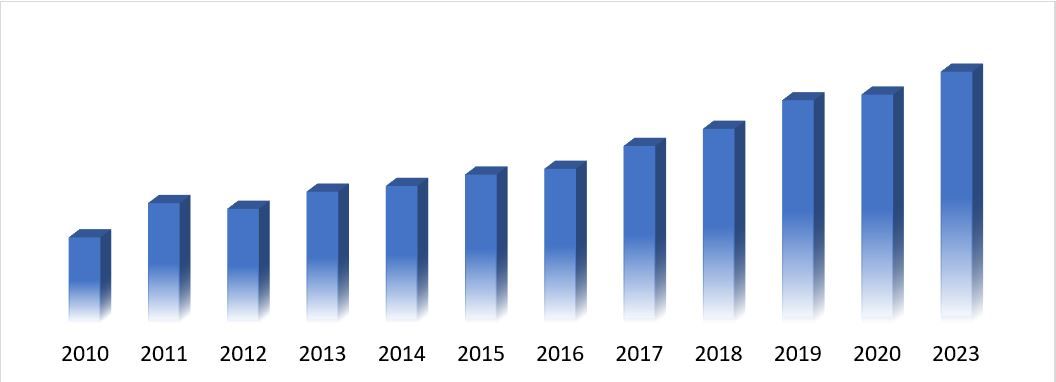- Home
- About Us
- Industry
- Services
- Reading
- Contact Us
Biodegradable Engine Oil Market: Current Analysis and Forecast (2021-2027)
Emphasis on Type (Vegetable Oils, Polyalkylene Glycols, Synthetic Esters, Others); Application (Agriculture, Transportation, Construction, Others); Region and Country
Biodegradable Engine Oil Market was valued at US$ 900 million in 2020 and is expected to grow at a CAGR of 4% over the forecast period (2021-2027). Biodegradable Engine Oil are also referred to as bio-lubricants and bio-lubes, are those lubricants that are biodegradable and non-toxic in nature. The raw materials used to make these lubricants include rapeseed oil, sunflower oil, palm oil, coconut oil, and animal fats. Bio-lubes are deployed in wide range of applications across various industrial domains including automotive, marine, construction, agriculture, among others.
World’s air quality is degrading rapidly as the air pollution levels are on rise across the globe which may pose major health risks to global population. For instance, as per the World Health Organization, nearly 7 million deaths are attributed to air pollution every year. Also, 9 out of 10 people breathe air that exceeds WHO guideline limits containing high levels of pollutants, with low- and middle-income countries suffering from the highest exposures. To tackle the degrading environmental changes and its negative impacts world leaders were legally bound to the Paris agreement in 2015. this agreement was joined by 191 parties and includes commitments from all countries to reduce their emissions and work together to adapt to the impacts of climate change. Owing to these concerns regarding deteriorating environment and various government regulations the biodegradable engine oil market is expected to witness growth in upcoming years.
Another significant reason responsible for the growth of biodegradable engine oil market is the rising demand for lubricants across the world owing to the growth in industrial sector. For instance, the global demand for lubricants was more than 36 million metric tons in 2018. this demand is anticipated to increase and reach 37.4 million metric tons by 2023. further, the global market value of lubricants is projected to reach USD 182.6 billion by 2025 with China being the leader of the global lubricants market as of 2019, accounting for market value roughly of 7.3 million tons.
Current and Forecasted Global Demand for Lubricants, 2010-2023 (in million metric tons)
BP, Castrol, Exxon Mobil Corporation, Royal Dutch Shell, Repsol, Croda International plc, FUCHS group, Total lubricants, Condat, SKF are some of the prominent players operating in the biodegradable engine oil market. Several M&As along with partnerships have been undertaken by these players to facilitate customers with hi-tech and innovative products.
Insights Presented in the Report
“Amongst Type, vegetable oils segment holds the major share”
Based on type, the global biodegradable engine oil market is fragmented into vegetable oils, polyalkylene glycols, synthetic esters, and others. The vegetable oils segment accounted for a market valuation of US$ XX billion in 2020 and is expected to reach US$ XX billion by the year 2027 growing with a CAGR of XX% over the forecast period. Vegetable oils in their natural forms can be used as lubricants in machinery as well as in industries as these oils have far superior lubricity than that of mineral oil. The high viscosity index, high flash points, less toxicity and biodegradable nature of vegetable oils is also adding pace to the growth of biodegradable engine oil market across the globe. For example, the viscosity index for soyabean oil is 223 which is much more in comparison to most petroleum oils i.e., 90-100.
“Amongst Application, transportation segment holds the major share”
Based on Application, the global biodegradable engine oil market is segmented into agriculture, transportation, construction, and others. The transportation segment accounted for a market valuation of US$ XX billion in 2020 and is expected to reach US$ XX billion by the year 2027 growing with a CAGR of XX% over the projected timeframe. The growth of this segment is attributed to the rising number of operating transports which in turn will increase in consumption of various lubricants including biodegradable engine oil on a large scale. For instance, In the year 2018, annual consumption volume of lubricants in cars was estimated to be around 258 million liters, up from about 208 million liters in 2015. Furthermore, the increasing focus of many automobile manufacturers for implementation of biodegradable engine oil in various automobiles is also driving the growth of this segment.
“Europe represents one of the largest markets of biodegradable engine oil market”
For a better understanding of the market dynamics of the biodegradable engine oil market, a detailed analysis was conducted for different regions across the globe including North America (the U.S, Canada, and the Rest of North America), Europe (Germany, France, Spain, United Kingdom, Italy, and Rest of Europe), Asia-Pacific (China, Japan, India, Australia, and Rest of APAC), Rest of World has been conducted. Europe dominated the market and generated revenue of US$ XX million in 2020 owing to the increasing adoption of biolubricants across countries such as Germany, France, etc.
Reasons to buy this report:
- The study includes market sizing and forecasting analysis validated by authenticated key industry experts
- The report presents a quick review of overall industry performance at one glance
- The report covers an in-depth analysis of prominent industry peers with a primary focus on key business financials, product portfolio, expansion strategies, and recent developments
- Detailed examination of drivers, restraints, key trends, and opportunities prevailing in the industry
- The study comprehensively covers the market across different segments
- Deep dive regional level analysis of the industry
Customization Options:
Global biodegradable engine oil market can further be customized as per the requirement or any other market segment. Besides this, UMI understands that you may have your own business needs, hence feel free to connect with us to get a report that completely suits your requirements.
Table of Content
Analyzing the historical market, estimation of the current market, and forecasting the future market of the Global Biodegradable Engine Oil Market were the three major steps undertaken to create and analyze the adoption of Biodegradable Engine Oil in major regions globally. Exhaustive secondary research was conducted to collect the historical market numbers and estimate the current market size. Secondly, to validate these insights, numerous findings and assumptions were taken into consideration. Moreover, exhaustive primary interviews were also conducted, with industry experts across the value chain of the Global Biodegradable Engine Oil Market. Post assumption and validation of market numbers through primary interviews, we employed a top-down/bottom-up approach to forecasting the complete market size. Thereafter, market breakdown and data triangulation methods were adopted to estimate and analyze the market size of segments and sub-segments the industry pertains to. Detailed methodology is explained below:
Analysis of Historical Market Size
Step 1: In-Depth Study of Secondary Sources:
Detail secondary study was conducted to obtain the historical market size of the biodegradable engine oil through company internal sources such as annual report & financial statements, performance presentations, press releases, etc., and external sources including journals, news & articles, government publications, competitor publications, sector reports, third-party database, and other credible publications.
Step 2: Market Segmentation:
After obtaining the historical market size of the biodegradable engine oil market, we conducted a detailed secondary analysis to gather historical market insights and share for different segments & sub-segments for major regions. Major segments included in the report as type and applications. Further country-level analyses were conducted to evaluate the overall adoption of biodegradable engine oil across the globe.
Step 3: Factor Analysis:
After acquiring the historical market size of different segments and sub-segments, we conducted a detailed factor analysis to estimate the current market size of biodegradable engine oil. Further, we conducted factor analysis using dependent and independent variables such as growing demand for lubricants and increasing no. of operating vehicles. A thorough analysis was conducted for demand and supply-side scenarios considering top partnerships, merger and acquisition, business expansion, and product launches in the biodegradable engine oil sector across the globe.
Current Market Size Estimate & Forecast
Current Market Sizing: Based on actionable insights from the above 3 steps, we arrived at the current market size, key players in the biodegradable engine oil market, and market shares of the segments. All the required percentage shares split, and market breakdowns were determined using the above-mentioned secondary approach and were verified through primary interviews.
Estimation & Forecasting: For market estimation and forecast, weights were assigned to different factors including drivers & trends, restraints, and opportunities available for the stakeholders. After analyzing these factors, relevant forecasting techniques i.e., top-down/bottom-up approach was applied to arrive at the market forecast about 2027 for different segments and subsegments across the major markets globally. The research methodology adopted to estimate the market size encompasses:
- The industry’s market size, in terms of value (US$) and the adoption rate of biodegradable engine oil across the major markets domestically
- All percentage shares, splits, and breakdowns of market segments and sub-segments
- Key players in the biodegradable engine oil market in terms of products offered. Also, the growth strategies adopted by these players to compete in the fast-growing market
Market Size and Share Validation
Primary Research: In-depth interviews were conducted with the Key Opinion Leaders (KOLs) including Top Level Executives (CXO/VPs, Sales Head, Marketing Head, Operational Head, and Regional Head, Country Head, etc.) across major regions. Primary research findings were then summarized, and statistical analysis was performed to prove the stated hypothesis. Inputs from primary research were consolidated with secondary findings, hence turning information into actionable insights.
Split of Primary Participants in Different Regions
Market Engineering
Data triangulation technique was employed to complete the overall market estimation and to arrive at precise statistical numbers of each segment and sub-segment of the biodegradable engine oil market. Data was split into several segments & sub-segments post studying various parameters and trends in the areas of type and applications of the biodegradable engine oil market.
The main objective of the Biodegradable Engine Oil Market Study
The current & future market trends of biodegradable engine oil were pinpointed in the study. Investors can gain strategic insights to base their discretion for investments from the qualitative and quantitative analysis performed in the study. Current and future market trends were determined the overall attractiveness of the market at a regional level, providing a platform for the industrial participant to exploit the untapped market to benefit as a first-mover advantage. Other quantitative goals of the studies include:
- Analyze the current and forecast market size of biodegradable engine oil in terms of value (US$). Also, analyze the current and forecast market size of different segments and sub-segments
- Segments in the study include areas of types and applications
- Define and analysis of the regulatory framework for the biodegradable engine oil industry
- Analyze the value chain involved with the presence of various intermediaries, along with analyzing customer and competitor behaviors of the industry
- Analyze the current and forecast market size of the biodegradable engine oil market for the major region
- Major regions studied in the report include North America, Europe, Asia-Pacific, and Rest of the world
- Company profiles of the biodegradable engine oil market and the growth strategies adopted by the market players to sustain in the fast-growing market
- Deep dive regional level analysis of the industry
Related Reports
Customers who bought this item also bought













